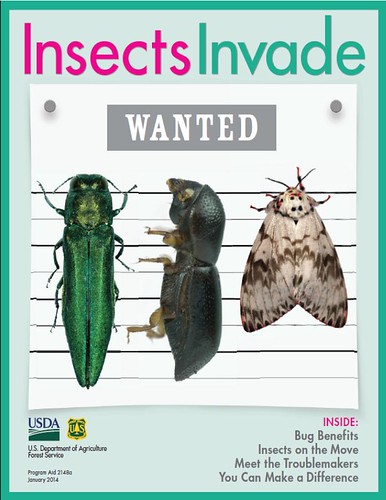
Our forests are under attack. And the U.S. Forest Service is hoping that the Nation’s fourth and fifth graders can help fight back.
The Forest Service distributed Insects Invade, a teacher’s package to 25,000 teachers nationwide. The teacher’s package includes 30 copies of a 12-page full color magazine called Insects Invade, a teacher’s page that has two lesson plans, as well as a comment card for feedback. The magazine was developed in conjunction with Scholastic Inc., a company that has delivered books, magazines and educational materials to schools and families for 90 years.
The Insects Invade educational product resulted as an idea to build awareness among fourth and fifth graders elementary school children about invasive insects.
“We hope this product helps initiates a dialog about invasive insects in our classrooms,” said Iris Vélez, the Forest Service National Symbols Program manager. “Invasive insects not only harm ecosystems, but also agricultural commodities. Invasive species is a global issue with serious economic implications and dramatic impacts to our ecosystems. With this product, young children will learn and understand the issue, its scope and potential impacts.”
Educators may purchase the Insects Invade teacher’s package for $4 per package, which includes shipping and handling.
There are several ways everyone can help make a difference in reducing invasive species:
- Do some research: You don’t even have to leave the comfort of your home. Get on the Internet and find out what invasive species have been found in your area, region or state. Identify which of those species might be living in your own backyard or neighborhood.
- Join in an eradication effort: Many parks and nature reserves manually remove invasive species (plants and animals) with the help of local volunteers. Your local national forest or grassland also may be looking for volunteers.
- Become a citizen scientist: Working outdoors can be a very rewarding way to combat invasive species. You could find ways to work alongside scientists collecting specimens or surveying areas.
- Visit a garden, park or nature center: Spend an afternoon at a botanic garden, park or natural area and familiarize yourself with the native flora and fauna in your area.
- Read a book: Not an outdoor type? Not to worry, even bookworms can participate by learning what you can about invasive insects and other invasive species. Knowledge is a powerful tool.
- Plant native in your garden: Replace your invasive landscape plants with native alternatives. Unlike many non-native plants, native plants are hardy, less susceptible to pests and diseases and unlikely to escape and become invasive. Your local landscape shop or county extension office can help.
- Spread awareness: Don’t keep your new-found knowledge to yourself. Tell your friends, family, neighbors and others what you have learned.
- Take the Invasive Species Challenge: One of the most effective ways to manage invasive species is for recreationalists such as boaters, fishermen, pet owners, and gardeners to not be unknowing vehicles of dispersion.
The Insects Invade magazine is the second product under the Woodsy Owl’s invasive species series. The first is “Invasive Weeds Activity Kit,” produced in 2003.
